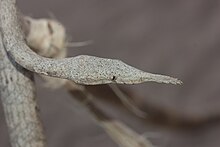| Langaha madagascariensis | |
|---|---|

| |
| Female L. madagascariensis | |
| Conservation status | |
 Least Concern (IUCN 3.1) | |
| Scientific classification | |
| Domain: | Eukaryota |
| Kingdom: | Animalia |
| Phylum: | Chordata |
| Class: | Reptilia |
| Order: | Squamata |
| Suborder: | Serpentes |
| Family: | Pseudoxyrhophiidae |
| Genus: | Langaha |
| Species: | L. madagascariensis |
| Binomial name | |
| Langaha madagascariensis Bonnaterre, 1790 | |
| Synonyms | |
| |

Langaha madagascariensis (formerly Langaha nasuta, commonly known as the Madagascar or Malagasy leaf-nosed snake) is a medium-sized non-venomous highly cryptic arboreal species. It is endemic to Madagascar and found in deciduous dry forests and rain forests, often in vegetation 1.5 to 2 meters above the ground.
Description
Malagasy leaf-nosed snakes can grow up to 1 meter in length. There is considerable sexual dimorphism within the species; the males are dorsally brown and ventrally yellow with a long tapering snout, while the females are mottled grey with a flattened, leaf shaped snout. The function of their appendage is unknown, but obviously also serves as camouflage. They have unusually slender bodies and can be identified by their long, pointy snouts. Their diet is mainly made up of frogs and lizards. These snakes are known for their unusually high levels of sexual dimorphism, (Tingle, 2012)
It is largely a sit-and-wait predator. It may show curious resting behaviour, hanging straight down from a branch. Prey items include arboreal and terrestrial lizards. It also exhibits hooding while stalking prey. These hooding and swaying behaviours along with its cryptic colour patterns, might allow L. madagascariensis to mimic a vine swaying in the wind.
Leaf-nosed snakes are oviparous with clutch sizes ranging from 5 to 11 eggs. Malagasy leaf-nosed snakes are generally calm and reluctant to bite unless provoked.
References
- ^ Raxworthy, C.J. (2011). "Langaha madagascariensis". IUCN Red List of Threatened Species. 2011: e.T172813A6922957. doi:10.2305/IUCN.UK.2011-2.RLTS.T172813A6922957.en. Retrieved 12 November 2021.
- Langaha madagascariensis at the Reptarium.cz Reptile Database. Accessed 3 May 2015.
- ^ Glaw, Frank; Vences, Miguel (2007). A Field Guide to Amphibians and Reptiles of Madagascar (3rd ed.). Köln: M. Vences & F. Glaw Verlags GbR. ISBN 978-3-929449-03-7.
- Andrew Durso (February 7, 2013). "Malagasy Leaf-nosed Snakes". Life is Short, but Snakes are Long. Retrieved 2 June 2013.
- Tingle, Jessica L. (2012). "Field observations on the behavioral ecology of the Madagascan leaf-nosed snake, Langaha madagascariensis" (PDF). Herpetological Conservation and Biology. 7 (3): 442–448.
- Kenneth L. Ksyco (2005). "Feeding behaviour of the Madagascar leaf-nosed snake, Langaha madagascariensis (Serpentes: Colubridae: Pseudoxyrhophiinae), with an alternative hypothesis for its bizarre head structure". African Journal of Herpetology. 54 (2): 195–200. Bibcode:2005AfJH...54..195K. doi:10.1080/21564574.2005.9635534. S2CID 84825762.
| Taxon identifiers | |
|---|---|
| Langaha madagascariensis | |